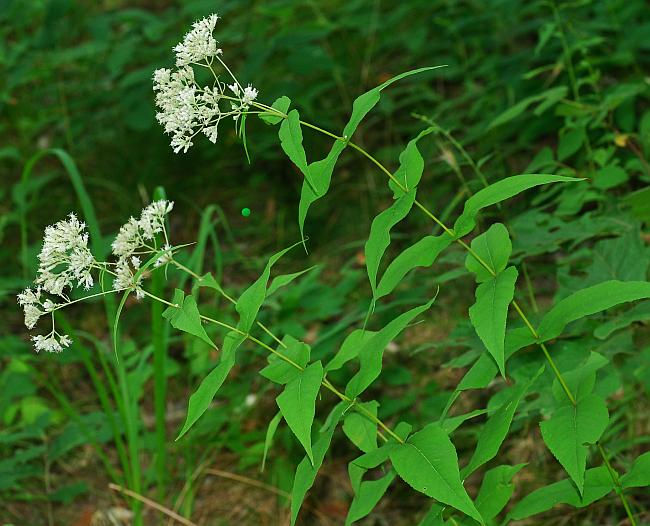Eupatorium sessilifolium L.
Upland Boneset

Native
CC = 7
CW = 5
MOC = 31
© SRTurner
Eupatorium sessilifolium L.Upland Boneset | |
 |
Native CC = 7 CW = 5 MOC = 31 |
© SRTurner |
|
Family - Asteraceae/Eupatorieae Habit - Fibrous-rooted perennial forb. Stem - Erect, to 1.2 m, glabrous below inflorescence, not hollow, tan or less commonly purplish brown, lacking axillary fascicles of small leaves.
Leaves - Opposite, simple, sessile, rarely with petioles to 2 mm. Blades 3-18 cm long, 8-60 mm wide, lanceolate to narrowly ovate, rounded, truncate or shallowly cordate at the base, the bases of the pairs often somewhat overlapping, tapered to a sharply pointed tip, the margins sharply toothed, the surfaces glabrous, also sparsely to moderately gland-dotted, with 1 main vein.
Inflorescence - Terminal panicles of small heads, often flat-topped.
Heads - Discoid. Involucre 4.5-6.5 mm long, cup-shaped, the bracts ovate to lanceolate or narrowly oblong, rounded to bluntly or less commonly sharply pointed at the tip, the margins thin and pale or transparent, mostly faintly 3-nerved, densely short-hairy, green.
Florets - Usually 5 per head. Corollas 3-4 mm long, white, the surfaces often glandular. Styles well exserted at anthesis. Pappus of numerous capillary bristles.
Fruits - Achenes 2-3 mm long. Flowering - July - September. Habitat - Forests, bluffs, streambanks. Origin - Native to the U.S. Lookalikes - Other species of Eupatorium. Other info. - This plant is less common in Missouri than some of the more weedy members of the genus. It is found mainly in the Ozark region and also the eastern portion of the Glaciated Plains. Beyond Missouri its range extends in a broad band eastward to the Atlantic Coast. It is recognized as a Eupatorium by its panicles of numerous small, discoid heads, which often have a "dirty dishwater" off-white color. The specific ID is provided by the leaves, which have rounded, sessile bases, with the bases of nodal leaf pairs abutting or even overlapping. It seems to prefer growing in the understory, in lightly wooded areas or near forest margins. Photographs taken at Cuivre River State Park, Lincoln County, MO, 9-29-2012 and 8-15-2014 (SRTurner). |